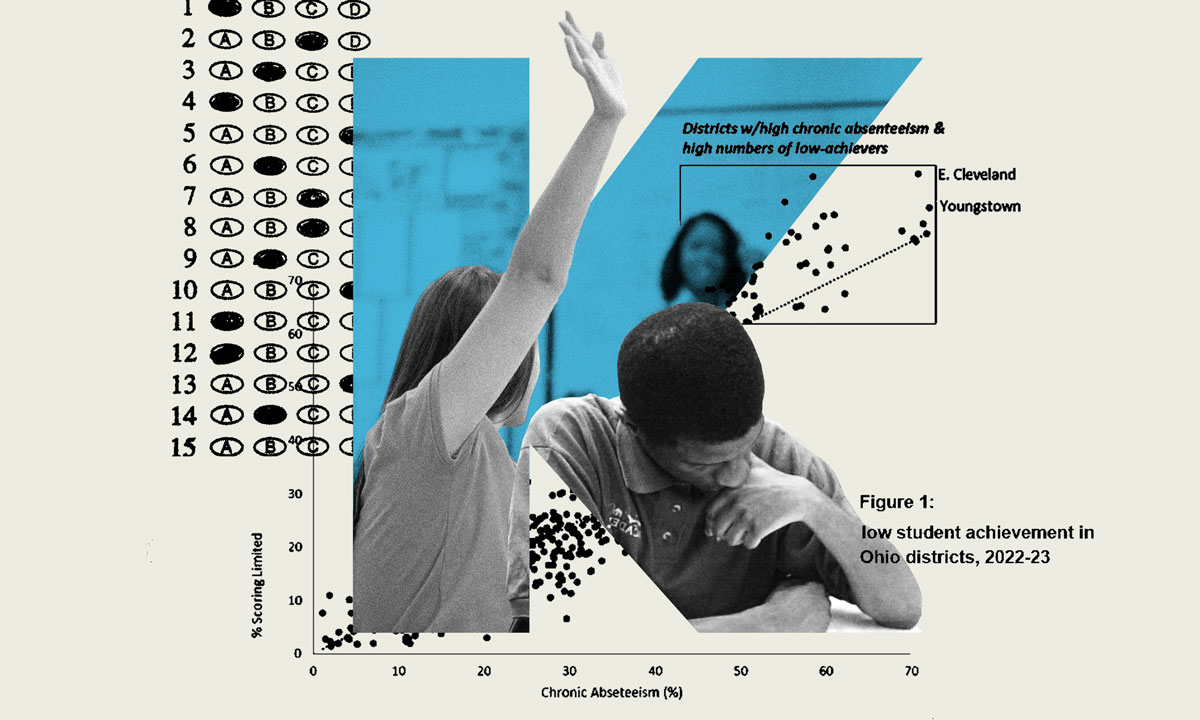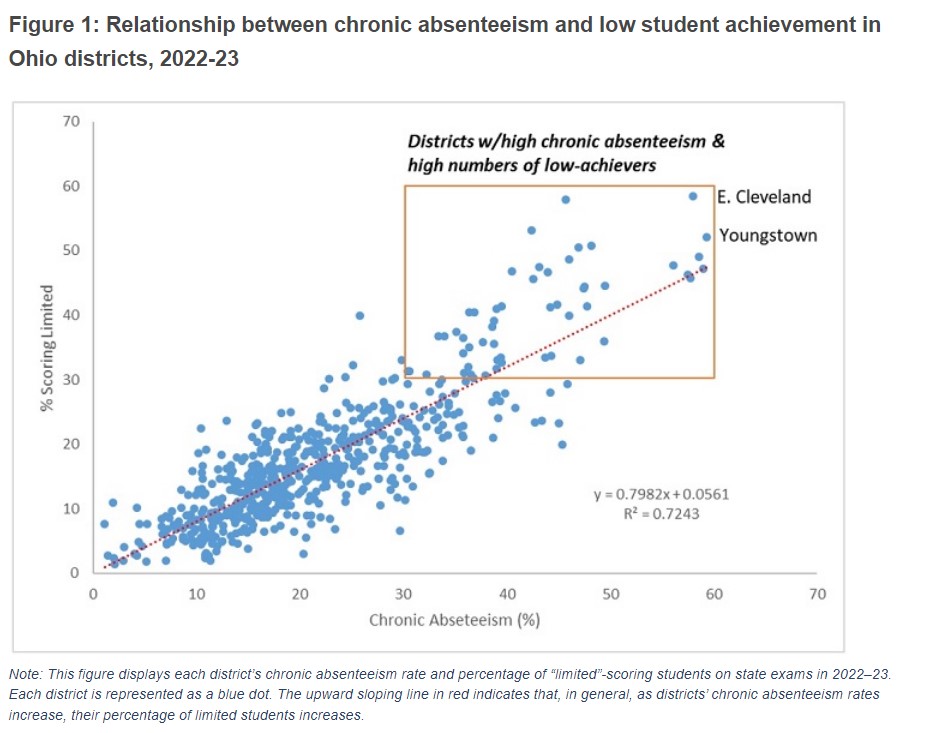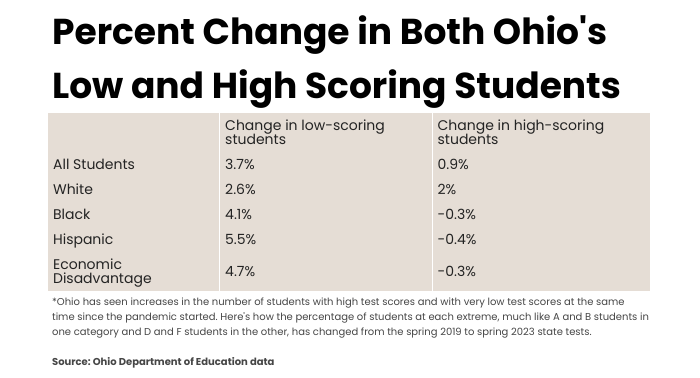A Tale of Extremes: More High & Low Scores in Ohio’s K-Shaped Learning Recovery
Many Ohio students are beating pre-pandemic test scores while absenteeism seems to drive an increase in failing students.

Get stories like these delivered straight to your inbox. Sign up for The 74 Newsletter
Ohio’s academic recovery has been a tale of two extremes, with many of the best students doing as well or even better in English than before the pandemic — even as more students have plummeted to the bottom.
Led by white and affluent students, Ohio saw a rise in high scoring students on this spring’s state tests, even as the number of low-scoring students, mostly Black, Hispanic and low income, is also up since the pandemic.
“At the high end, we’re seeing more kids actually scoring at the advanced level,” interim state Superintendent Woolard told The 74. “Some of the higher performing students are doing well, but you’re not necessarily seeing it on the lower end.”
“It’s not uniform,” he said.
Woolard called the results “sort of a K-shape,” in which one leg — the strong students — have trended upward while the other leg — the struggling students — remains sharply down.
The pattern also mostly holds for historically-challenged demographic groups, such as Black, Hispanic or low-income students who saw big increases in low scores. At the same time, the small number of high-performing students in the same groups have nearly recovered to pre-pandemic levels.
In a further highlight of an uneven recovery, 109 of Ohio’s 607 districts had higher scores on spring 2023 tests than before the pandemic, while students in the remaining districts scored lower.
Woolard and other education experts said a significant factor holding many students back is the ongoing issue of students missing school. Mirroring a national trend, Ohio’s chronic absenteeism, students missing 10 percent or more of school days, has soared.
Statewide, chronic absenteeism increased from 17 percent of students in 2018-19 to 27 percent in 2022–23. In some urban districts, more than half of students are considered chronically absent
Nationally, chronic absenteeism rates nearly doubled from 2019 to 2022 and a just-released report found that nearly two out of three students nationally attended schools with high absenteeism in 2021-22. But data from many states for 2022-23 is still rolling out.
Fordham Institute researcher Aaron Churchill found a clear relationship between students scoring as “Limited,” the lowest level on recently-released state tests, and the district’s rate of chronic absenteeism. Some of the districts with the biggest increases in absenteeism have the greatest number of students scoring at the bottom.
Churchill couldn’t declare absenteeism as the cause of score drops, though many have hinted at it nationally. But he said it is definitely a factor.
“There has been much discussion about how to boost achievement, but one of the most basic ways to move the needle might be hiding in plain sight: simply making sure that students attend school,” Churchill wrote in Fordham’s Ohio Gadfly blog.

Woolard’s analogy of the K-shaped recovery is based on Ohio’s scoring levels on state tests.
Ohio divides students into five categories — Limited, Basic, Proficient, Accomplished, and Advanced — that can be likened to A-F grades. A sixth category Advanced Plus is tacked on for further differentiation of top scorers.
Setting aside the middle proficient category and just focusing on the higher and lower ends, which can be likened to A and B students or D and F students, a pattern emerges, Woolard said.
At the very bottom, limited students increased by 4.5 percentage points, 15.9 percent in 2019 to 20.4 this spring. That means that one in five Ohio students now score at the bottom, compared to one in 6 pre-pandemic.
Advanced students also increased from 17.1 percent in spring 2019 tests to 19.6 percent in spring 2023.
“Kids that were proficient anyway, they may be accelerating even more,” Woolard said.
White students statewide typify this trend. While the percentage of white students scoring below proficient increased 2.6 points since the pandemic, they also had a 2 point increase in those scoring accomplished or advanced.
Black, Hispanic and low income students had a similar pattern, with big increases in the number of students scoring poorly. Hispanic students, for example, had the largest increase in low-scoring students with a 5.5 percentage point jump from pre-pandemic.
Though all three groups failed to add more students in the top-scoring categories, marking a significant difference from white students, the declines since 2019 in accomplished and advanced students are tiny — well below a percentage point — suggesting that the best students in these groups have mostly rebounded and held their own.

The Solon school district about a half hour east of Cleveland had the highest scores on this spring’s state tests of any district in Ohio, because of a small increase in accomplished and advanced students. It remains slightly behind its 2019 scores, though, because of a small increase — from 1.1 percent to 2.3 percent — in limited and basic students.
Superintendent Fred Bolden said students in the affluent and mostly-white district, who score at or near the top of the state every year, had the advantage of already having computers before the pandemic as well as parents that are more affluent than in cities.
“When you have a student that can successfully operate on advanced levels, those students are oftentimes more self-directed…they have the necessary executive function skills to work independently and to continue to excel in the instruction that we’re giving them,” Bolden added.“When you have students that are proficient or… are not quite there, there can be some things that prevent them from continuing to be successful.”
Get stories like these delivered straight to your inbox. Sign up for The 74 Newsletter


